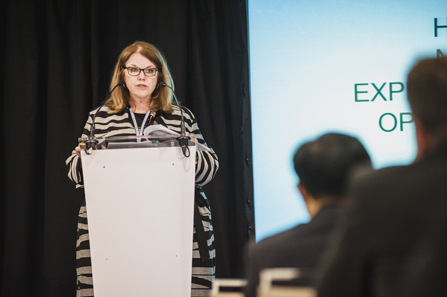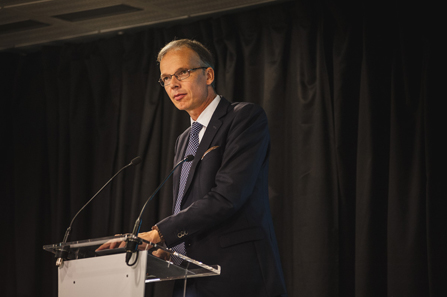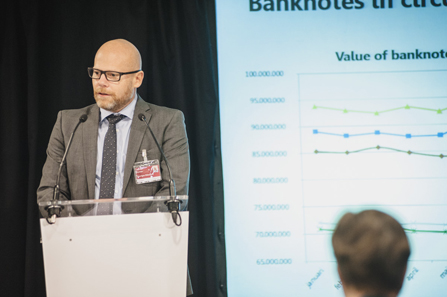by Ursula Kampmann
translated by Annika Backe
November 12, 2015 – Between October 21 and 23, 2015, the Coin Conference took place in Madrid. In seven sessions, topics revolved around circulating coins. Logistics, security, cost efficiency, progress of cashless payment and sustainable mint management were at the center of attention. CoinsWeekly gives a brief summary of the lectures presented during the conference.
In the first part, we report on new trends and present insights from new coin series from Sweden and Mexico.
Session 1: Trends and challenges
Astrid Mitchell, Currency News: The Circulating Coin Market – An Update
What has changed during the last two years since the previous Coin Conference in Berlin? Where are mints as well as circulating coins heading? In her programmatic talk, Astrid Mitchell, on behalf of Reconnaissance organizing the two-day conference, presented the most important developments.
To begin with the positive news: The cries of naysayers speaking of cash being used less and less often notwithstanding, the amount of circulating money has in fact increased, both on a global scale and within the euro zone. Worldwide, circulation volumes increased from 846 to 973 billion. Annual coin demand rose from 42 to 40 billion. More and more bi-metallic coins are produced in the light of increased safety requirements particularly in the upper range value.
13 % of all newly-produced coins currently consist of a ring and a core. To save production costs, 38 % of all denominations are currently galvanized. However, a good half of all coin types – 49 %, to be specific – are still made of a standardized nonferrous-metal alloy. There is an enormous potential for savings in this segment, therefore.
After all, cost efficiency still proses a great problem to the central banks. The high metal prices of the previous years have led to a negative seigniorage, especially in regards to the smaller denominations, which the central banks intend to compensate with smaller and lighter blanks, and by switching to galvanized steel blanks.
Some countries, on the other hand, decide to remove the smaller denominations for good.
Generally speaking, the smaller denominations pose an ever-growing problem to the central banks. Those coins are the most expensive to produce. Besides, they are an invitation to hoard, and so a vital question to deal with in the future will be how to make the ultimate consumer puts the smaller denominations in circulation again.
While the smaller denominations disappear in the lower ranges, the threshold between coins and banknotes is actually rising. The coins of a higher value often counterfeited, it is important to solve a few security issues in this regard. Several new security features are currently developed but it is still hard to tell which ones will prevail in the long run.
55 mints are currently producing the nearly 49 billion coins required for circulation worldwide every year. This makes an average production of 0.9 billion coins for every mint. When compared with banknotes, this is not very efficient. At present, 62 banknotes printing companies produce 2.75 billion banknotes every year, to meet the worldwide demand of 170 billion.
Astrid Mitchell concluded her presentation by saying that the minting industry currently faces great challenges. Only the most innovative mints stand a chance to stay on the competitive market.
Genie Foster, International Association of Currency Affairs. Photograph: Reconnaissance.
Genie Foster, International Association of Currency Affairs: Payment Trends
The pivotal question was asked by Genie Foster in her presentation: Are young consumers giving up cash? When standing at a supermarket checkout, every consumer can see how payment performance is changing – not at the same rate in all countries, and, most of all, not to the same extent in every generation.
The biggest threat to the traditional wallet is currently the smartphone which has become a permanent companion today, on the one hand, and online trade where cash is of no use, on the other hand. It is mainly juveniles, which are not so much set in their ways as the elderly, who are rather willing to be convinced of the advantages of cashless payment.
The strongest argument against paying cashless is that it is not at all necessary. If there is no need to pay cashless, the customer will not try out this option. To avoid expensive cash logistics and collect customer data, it is in the interest of the commercial chains, therefore, to install benefit schemes and hence bring their customers to use their debit card for cashless payment.
The trend is towards cashless payment but only time will tell if cash will actually be removed for good.
Rüdiger Voss, European Commission, Directorate-General Economic and Financial Affairs. Photograph: Reconnaissance.
Rüdiger Voss, European Commission, Directorate-General Economic and Financial Affairs: Possible Building Blocks for a More Modern Euro Coinage System
In his presentation, Rüdiger Voss addressed a number of different problems the euro is currently facing. How to accommodate the requirements of such different countries as Luxemburg and Latvia in terms of the scale of denominations, for example? While, according to the Payne & Morgen calculation formula from 1981, the lowest coin in Luxemburg had to be 2.8 euro cents, Latvia would need a coin worth 0.36 euro cents, in contrast.
Rüdiger Voss also spoke about the problem that the smaller denominations, the 1 and 2 cent coins, represent the biggest portion of European minting. This portion constantly rises, from 41.4 % in 2005 and 44.4 % in 2010, to 47.0 % in 2015. The demand for the lowest denominations, therefore, is rising faster than for the other denominations.
However, there remains the question of how to deal with the smaller denominations. While a recommendation from 2010 said that euro area member states shall refrain from adopting new rounding rules, a 2014 survey brought the result that a major part of the European population rather wants to abolish the smaller denominations altogether.
The euro zone witnesses only very limited counterfeiting, whereas the issue of the coin quantity has still not been satisfactorily resolved. The huge surplus production, of 1 euro and 50 cent coins in particular, generates enormous storage cost. For the 1 euro coin, there are currently 11.9 years of net issue in stock, while it is 8 years of net issue for the 50 cent piece, another 4.1 for the 2 euro coin, 3 for the 20 cent piece, and 2.7 for the 10 cent coin. The smaller denominations, in contrast, are almost out of stock.
New coin series:
Marten Gomer, Sveriges Riksbank. Photograph: Reconnaissance.
Marten Gomer, Sveriges Riksbank: Plans for Introducing Sweden‘s New Series
From north to south, the Swedish country stretches as far as 1.530 km. It has a population of 9.8 million. They dispose of 320 million banknotes in circulation, and nearly 2 billion coins in circulation. In a logistically extremely challenging project, all these coins and banknotes have to be exchanged for the new legal tender in 2016. Since 2008, the Swedish Riksbank is making the necessary preparations.
As a first step, the circulating coins and banknotes were evaluated. For reasons of safety, it was decided to issue a whole new series of banknotes which, for reasons of efficiency, were to be smaller and lighter, and no longer contain any nickel, for health as well as financial reasons. The 10 krona piece was the only one that was left untouched. Two additional denominations were decided to be introduced as well. The Riksbank proposed a draft design of the 20 krona coin that was to replace the 20 krona banknote, which, however, the parliament did not approve.
Right from the start, the Swedish Riksbank deemed it important to closely cooperate with the industry, resulting in a modification of the issue policy of the new currency. While the Riksbank had initially planned to make for a long transitional phase, the market, on the other hand, wanted to be given more time for making preparations but less time for the actual exchange taking place.
The specifications of the new coins, therefore, were determined as early as 2010. In 2012, the first test strikes were made, which allowed the vending industry to adjust their machines to the changeover. In 2015, mass production began. On October 3, 2016, the coins will be issued. The Swedish Riksbank is particularly happy about the reduction of costs. The price for the 1 krona piece was reduced from 70 SEK to 0.13 SEK, while the price for the 5 krona coin dropped from 1.50 SEK to 0.43 SEK.
However, the problem of the withdrawal of the old currency still remains. The leading commercial banks have agreed to commision a jointly operated logistics company. It will collect the circulating cash in the sparsely populated country and store it in a central depository. Statistically speaking, every Swedish household disposes of 779 krona cash. According to the calculation of the Riksbank, that makes nearly 1.3 billion 1 krona coins and 265 billion 5 krona coins to be collected.
To Sweden, one of the pre-requisites of the monetary reform was that every party involved was to meet its expenses. Despite of the costs for the production of the new currency, the replacement of the coins and banknotes nevertheless seems to pay off for the Swedish tax payer: The production of the new banknotes cost 250 billion SEK, the production of new coins another 110 billion SEK. 40 billion SEK were spent on communications, and 30 billion SEK on storage. Other costs amounting to 20 billion SEK added, this results results in cumulative costs of 450 SEK, less metal costs of the coins collected and seigniorage of the coins and banknotes that are returned too late. As for the coins, the Swedish Riksbank estimates that only between 30 and 50 % will be replaced.
Alejandro Alegre, Banco de México: Mexican Circulating Coins: Recent Events and Future Projects
Different solutions for solving the problem of the gap between production costs and nominal value have been found by the Mexican Central Bank. It resorted to an action that is based on a measure taken in 1997. Back then, the production costs of a 5 cent coin amounted to an estimated 13 or so cents. Public demand for this denomination having dropped anyway, the Central Bank, without informing the public in advance, decided to cut the production by 50 %. With supplies lacking, the demand for the 5 cent coin slumped in 1998. In the following years, the demand kept falling, coming close to zero in 2005. There were no public complaints although there were likewise no official estimates on the impact that this may have had on the inflation.
The current coin series in Mexico stems from 2009. It was intended to considerably save expenses. Because of this, the Mexican Central Bank changed the alloy of which the 20 and 50 cents coins were minted from bronze-aluminum to stainless steel. It also started using the center of the 1, 2 and 5 pesos coins to make the 10, 20 and 50 cents coins.
The customers, on the other hand, did not readily accept the new smaller denominations. The new coins are too small, and it is easy to confuse their denomination. Since 2009, therefore, Mexico knows the negative side effect of an increased loss rate all too well. Theoretically speaking, as of June 2015, 91 coins per capita of the 10 cent coins were in circulation. The 10 cent coins thus constitute 36 % of all circulating coins, but only 3 % of the value of coins in circulation. Furthermore, these denominations have a negative seigniorage, as the production costs of both the 10 and 20 cents amounts to around 30 cents.
In regards to the 5 cent coins, the Central Bank of Mexico hence plans to resort to the 1997 measures a second time. Without giving any official announcement, the production of 10 and 20 cent coins will be cut back successively. The withdrawal of 10 and 20 cent coins would have an effect on inflation between 20 and 38 basis points but no permanent impact on the inflation rate.
Moreover, the Mexican National Bank will change the procedure for banks. Having been forced to order certain denominations as a package, banks’ orders had been distorted. As of May 2014, the Mexican banks are now allowed to order only the amount of coins they are in actual need of.
Since 2013, the Mexican National Bank has issued five 20-peso commemorative coins. As a matter of fact, it now faces a problem known in Germany as well: Many dealers refuse to accept commemorative coins as legal tender. A large-scale media campaign was launched, and successfully introduced the new coins, on the one hand, and made the Mexican people take more pride in their currency, on the other hand.
In the final part of his presentation, Alejandro Alegre presented a new coin series to be released in 2018. It will coexist with the current coin series. An estimated cost reduction of 11.3 million USD per year is hoped for, to be achieved by reducing the current nine denominations to only six. In addition, a 20 peso coin will replace the 20 peso banknote. As security features, it will be equipped with a latent image as well as a microtext. The themes will be well-known monuments and buildings covering all of Mexico’s historic stages.
The next sessions of presentations you may find here:
Part 2: cash logistics
Part 3: security features and social responsibility
Here you can find the homepage of the Coin Conference.
A good review of what was going on is provided here.
This is the link for the conference attendees to download most of the speakers’ PowerPoint presentations.
Please learn more about the host of the Coin Conference by accessing this site.







